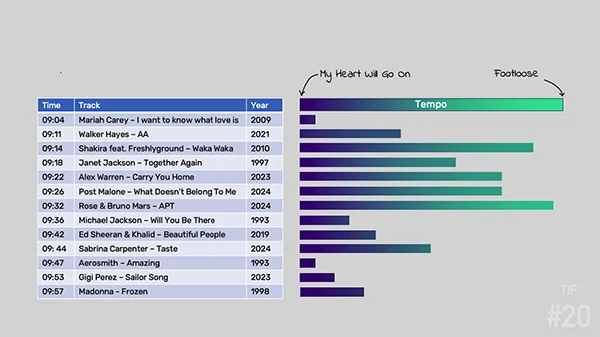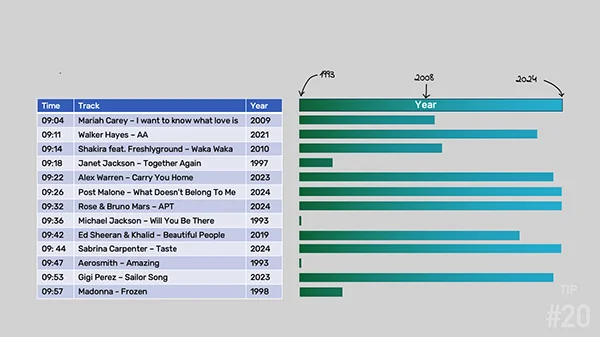Tempo Analysis: A Rollercoaster Without a Destination

The sample hour’s flow resembles a sand clock abruptly flipped mid-fall - beginning with the slow, emotive weight of Mariah Carey’s "I Want to Know What Love Is" (09:04), gradually ascending through Shakira’s euphoric "Waka Waka" (09:14) and Janet Jackson’s danceable "Together Again" (09:18), only to peak abruptly with Rosé & Bruno Mars’ high-energy "APT" (09:32) before plunging back into the solemn depths of Michael Jackson’s "Will You Be There" (09:36) and Aerosmith’s 6-minute ballad "Amazing" (09:47).
Why This Matters:
Listener Moods Aren’t Mind Readers: A tempo arc this erratic assumes audiences will mirror its swings - from reflective to euphoric to somber, within minutes. In reality, most listeners seek consistent energy aligned with their daily routines (e.g., mornings = upbeat, evenings = relaxed).
Cognitive Dissonance: The whiplash between "APT" (140 BPM, celebratory) and "Will You Be There" (70 BPM, gospel-tinged) isn’t just a tempo shift: it’s a cultural and emotional disconnect. Gen Z fans of Rosé may flee, while Gen Xers drawn to Michael Jackson may resent the prior Gen Z skew.
Missed Opportunity:
The mid-hour energy peak ("Waka Waka" → "Together Again" → "APT") suggests a natural momentum the station could harness. Instead, the subsequent slowdown (Michael Jackson → Aerosmith) halts that energy like a power outage at a party.
Fix It Without Altering Variety:
Cluster Tempos Strategically: Group upbeat tracks (e.g., Shakira, Janet Jackson, Rosé) for daytime energy.
Reserve ballads (Mariah Carey, Michael Jackson) for evening wind-down.
Bridge the Gaps: Transition "APT" → "Beautiful People" (Ed Sheeran/Khalid) instead of "Will You Be There" - both modern, mid-tempo.
Save Aerosmith’s "Amazing" for a dedicated "Slow Jam Hour" where it feels intentional, not disruptive.
Test the "Sand Clock" Theory
If contrast is the goal, frame it: "We’re flipping the mood - from fiery to introspective. Next up: Michael Jackson’s ‘Will You Be There’ after Rosé & Bruno Mars." Without context, these shifts feel accidental, not curated.
Conclusion:
Tempo is a tool, not a toy. Used thoughtfully, it guides listeners through moods seamlessly. Used haphazardly, it becomes audio whiplash. This playlist has the bones of decent momentum - it just needs a conductor.


